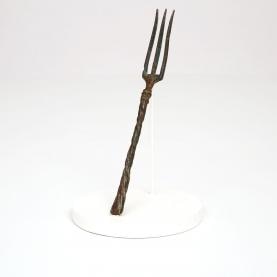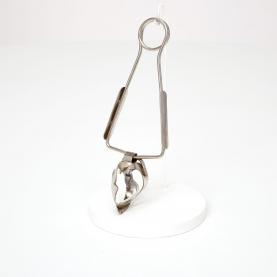The Fork
The fork is clearly an object that is emblematic of Western culture, with complex origins that blend legends and differing accounts of how it was used.
We do not know exactly when the fork first appeared nor, for that matter, if there is even a recognised definition of the object. Although everyone agrees what a spoon or a knife is, the definition of a fork is somewhat unclear. General consensus holds that it is a table utensil used to prick food to pick it up, to pass it from a serving dish to a plate, to hold it whilst cutting and to carry it to the mouth. But, for there is a big ‘but’, it is not exactly the same thing to prick food from a collective dish or an individual plate, or to prick food to carry it from one place to another, or to carry food to the mouth. And, we will come back to this later, is it really the same object as the two-pronged fork, which is basically more of a serving cutlery item, or the small individual four-pronged dessert fork? Various dictionaries address this issue, defining the fork as a ‘two, three or four-pronged utensil’. It is worth mentioning, however, that the word did not appear in the French language before approximately 1300.
Semi-legendary beginnings
All of this does nothing to resolve the issue of the fork’s origins. It is, however, sure and certain that utensils were used in Antiquity to prick food from dishes, witnessed by the fact that they have been discovered in archaeological digs in the Middle-East and in Egypt. Yet their purpose is not clear and it seems they were used more as serving utensils than to carry food to the mouth. The fork is thought to have appeared in Italy around the year 1000, in Venice, and in addition to its recorded use as a cutting aid, it is also said to have been used to eat the first pasta. As of the Middle Ages, utensils resembling two-pronged forks were mentioned in several French Kings’ inventories. We can therefore safely assume that the fork was still only a serving utensil at the time, not used individually and had seemingly not conquered European tables, let alone French tables. How it arrived in France is an old story: It is reported to have arrived in Catherine de Médicis’ trunks, along with numerous other refined Italian items. Another legend states that Henry III discovered it during a trip to Venice and adopted it for his personal use, finding it practical when wearing ruffled collars (weightless pleated collars), which were fashionable at the time.
In reality, its dissemination as a utensil to carry food to the mouth is more likely to have happened progressively in Europe as of the end of the Middle Ages, most probably beginning in Italy. A few specimens have been found from around this time and forks also appear on certain paintings and in inventories.
A very slow dissemination
The fork acquired its current physiognomy during the 17th and 18th centuries. The very straight and very sharp two-pronged model remained a serving cutlery item. It was used to hold food to be cut and to serve the pieces. Then came the individual fork, with three and later four slightly curved prongs. Although it could still prick food, the whole design had softened greatly. The end of the prongs was softened to avoid injuring the tongue when putting the fork in the mouth. It was now much easier to pick up the food, either by pricking it, like with meat, or by placing it in the bend of the fork. The increase in the number of prongs, as well as the resulting reduction of space between them, made the fork an ideal substitute to the spoon for non-liquid foods.
We can assume the double novelty of being able to prick food delicately as well as picking it up in the bend of the fork encouraged carrying the food to the mouth. It thus became progressively easier to eat using a fork than using fingers.
However, we cannot say that it was adopted extensively or quickly. It remained a precious object reserved for the elites, but not even for all of them. We know that Louis XIV did not like to use it and persisted in eating with his hands. Having said that, it became increasingly common for European elites to own cutlery engraved with their coat of arms, and to carry a fork and a spoon around to use to eat their meals. Practices evolved progressively and, as of the 18th century, it became the host’s duty to provide their guests with such utensils, which often included the householder’s engraving. This was also the opportunity for every European country to adopt the fork in their own way. In France, it became customary to place the fork’s prongs downwards on the table, thus clearly displaying the engraved coat of arms on the back of the handle. In England, the engraving was reversed and the fork was positioned with its prongs facing up. There is no entirely satisfactory explanation for these different practices. The most commonly accepted reasoning is that. in France, the prongs facing downwards gave a less aggressive image, while the prongs facing up in England avoided staining the table cloth.
A great diversity
The late 18th century and the early 19th century marked a key turning point in the history of table manners and the use of table utensils. The evolution of eating habits, with the famous transition from the French-style service to the so-called ‘Russian-style’ service was an important time in the history of the fork.
Henceforth, different utensils were placed on the table adapted to each dish. In the case of cutlery, it was an opportunity to invent many variations and hence many types of forks. Alongside the traditional table forks came dessert, fruit, fish, oyster, shellfish, snail, and even melon forks. Variations in serving cutlery also appeared at that time, in the shape of fish, carving, salad and hors-d’œuvre serving forks and even the more original pickle and gherkin forks found on bourgeois tables. This list defined the new table refinement and style of service adopted at the beginning of the 19th century. Dishes were served one after another, which caused a change in the way the table was laid.
A shape for each use
Table utensils, and hence forks, were brought to the table at the same time as the different dishes. Thus several forks were required per guest. At the time people estimated a guest would require a minimum of three forks. This corresponded to eating at least one starter and two dishes, one roasted and the other with sauce.
Recent developments
The fork’s history in the 20th century involved simplifying models and diversifying materials. Models became simpler as the contemporary table became increasingly plain. This phenomenon has a dual origin. As the century unfolded, tables and dining rooms became smaller. In addition, Nouvelle Cuisine and its influence on the art of the table led to tables being laid in a significantly simplified way. The combination of these two points gradually put an end to the great diversity of the 19th century. In most cases, only table forks and dessert forks remain. Oyster forks are rare, and other types have almost disappeared from both tables and manufacturers’ catalogues. In contrast, as it is essential for eating, the fork, like all items of cutlery, is undergoing a great transformation, not in its shape but in the materials used to manufacture it.
Variety of the manufacturing materials
While the first forks had iron teeth, they slowly began to be manufactured in precious metals such as silver, vermeil and gold. The widespread use of the fork and its dissemination throughout the wider community in the 19th century was an opportunity for great diversification. The cheapest forks continued to be made of iron, or of a poor pewter or copper alloy, such as brass. Along with the discovery of the gold and silver plating processes using electricity, brass became the basic material in the middle of the 19th century, substituted by nickel silver as of 1860-70. This was referred to as white metal, as it is silver in colour. Aluminium cutlery and forks appeared at the end of the century. As the 20th century arrived and portable food developed, plastic found its way onto tables and picnic blankets, whilst stainless steel became the most widely used material.
Having become an essential item on Western tables, the fork has also become an emblematic object. The world’s population can be approximately divided in three thirds in terms of how food is eaten: The first third eats with their hands, the second with chopsticks, while Westerners, broadly speaking, use a fork.




















